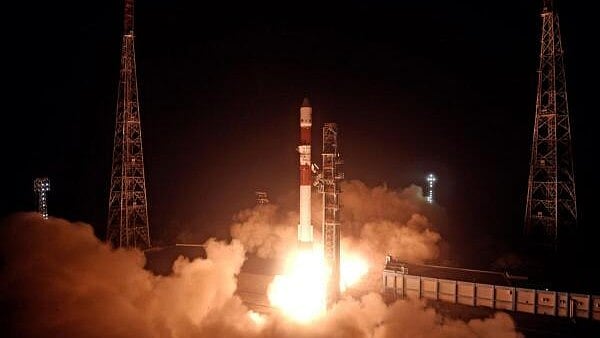
ISRO's PSLV-C60 carrying SpaDeX and its payloads, lifts off from the first launch pad at Satish Dhawan Space Centre, in Sriharikota, Andhra Pradesh, Monday, Dec. 30, 2024.
Credit: PTI Photo
Chennai: Ending 2024 in style, the Indian Space Research Organisation (ISRO) on Monday night launched the PSLV-C60 Space Docking Experiment (SpaDeX) aimed at developing and demonstrating crucial technology required to dock and undock spacecrafts in space from the Satish Dhawan Space Centre (SDSC) in Sriharikota.
This cost-effective in-space technology is crucial for India’s lunar missions like India’s manned mission to the moon, Gaganyaan, sample return from the Moon, and the building and operation of the planned Bharatiya Antariksh Station (BAS).
Monday’s launch was ISRO’s fifth mission in 2024 with the space agency having begun the year with the successful launch of the country’s first dedicated satellite to study black holes on January 1.
PSLV-C60, which blasted off at 10 pm on Monday from the first launchpad of the SDSC, carried two small spacecraft, each weighing 220 kg, and placed them into a 475 km circular orbit after 15 minutes of the launch, as planned. Both spacecraft – SDX01 (chaser) and SDX02 (target) -- were placed in an orbit to keep them 20 km apart from each other.
Scientists at ISRO over the days will reduce the distance between them to 3 metres, ultimately leading to the docking of the two spacecraft with the entire process set to be completed approximately by January 7. If the mission is successful, India will be the fourth member to join the elite club of nations possessing space docking technology after the US, China, and Russia.
“I am really happy to announce the successful accomplishment of the launch of PSLV-C60 SpaDeX mission. The rocket has placed the satellites in the right orbit, which is a 475 km circular orbit. That’s only one part of the mission, the injection of the SpaDeX satellites,” ISRO chairman S Somanath announced.
He added that the second part of the mission, the PS4-Orbital Experiment Module (POEM) operations, with 24 payloads from ISRO, start-ups and academic institutions will be fired late Monday night, while asserting that 2025 will witness “many launches” beginning with NVS-02, a navigation satellite, in January.
"SpaDeX satellites have moved one behind the other, and over a period of time, it will pick up further distance, travel about 20 km away and then the rendezvous and docking process will start,” he said. M. Sankaran, Director, U R Rao Satellite Centre, said the mission was ISRO’s “new year gift” to India.
After successful docking and rigidisation, electrical power transfer between the two satellites will be demonstrated before their undocking and separation to start the operation of their respective payloads for the expected mission life of up to two years, scientists said, adding that in-space docking technology is essential when multiple rocket launches are required to achieve common mission objectives.
The mission will also demonstrate several indigenous technologies, including a sophisticated docking mechanism, rendezvous and docking sensors, power transfer technology, autonomous rendezvous and docking strategy, and inter-satellite communication link (ISL) for autonomous communication between spacecraft.
Owing to its small size and mass, SpaDeX is even more challenging due to the finer precision required for the rendezvous and docking manoeuvres compared to docking two large spacecraft. “This mission will be a forerunner for autonomous docking needed for future lunar missions like Chandrayaan-4 without the support of GNSS from Earth,” the ISRO said.
The payloads include a high resolution camera mounted on SDX01 to capture the process of rendezvous, docking and undocking, while SDX02 carries a miniature multi-spectral payload (MMX) whose imaging is useful for natural resource monitoring and vegetation studies and a radiation monitor to measure radiation dose encountered in space.